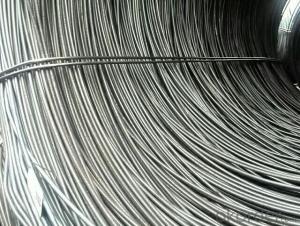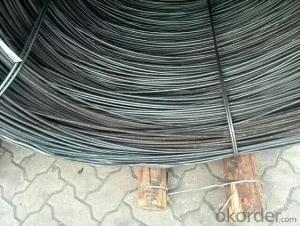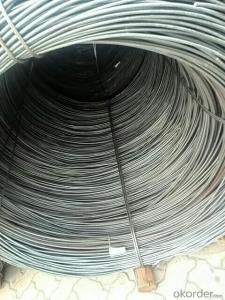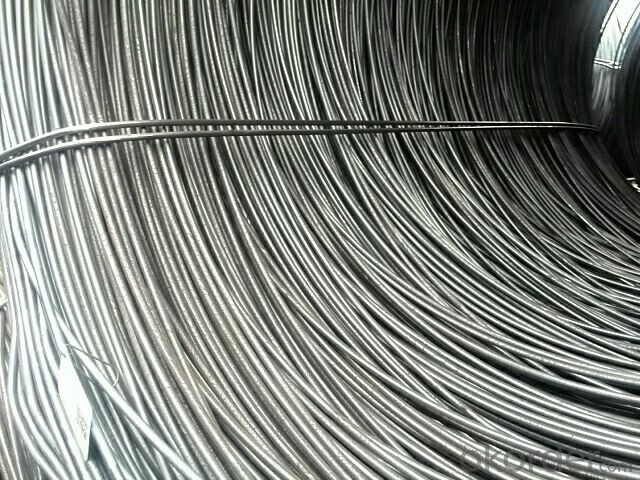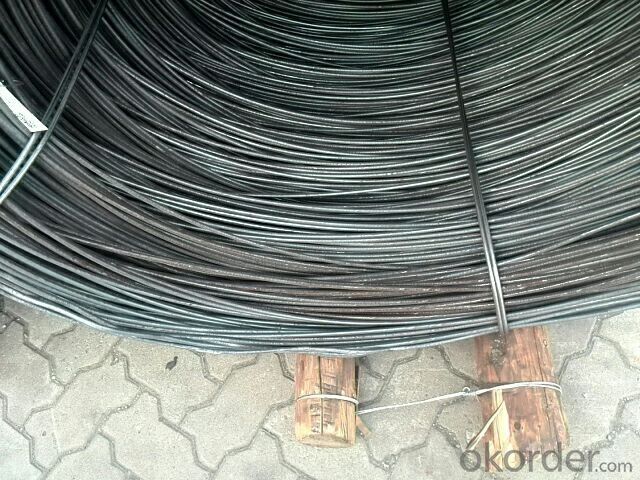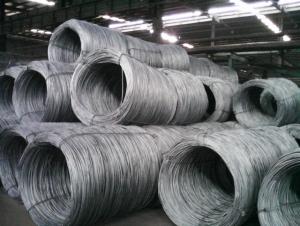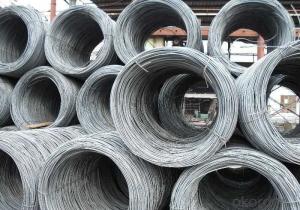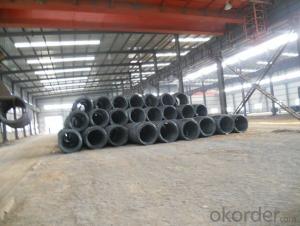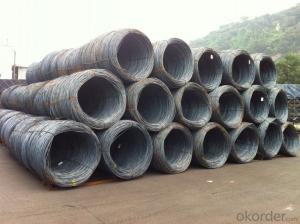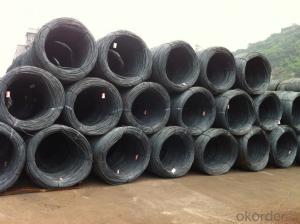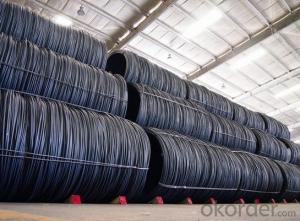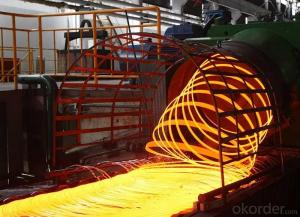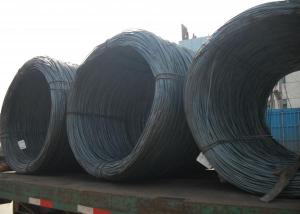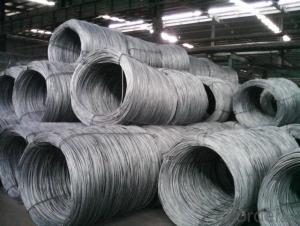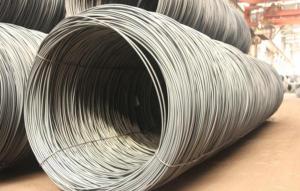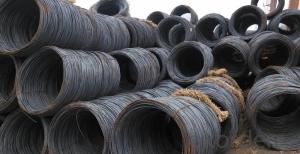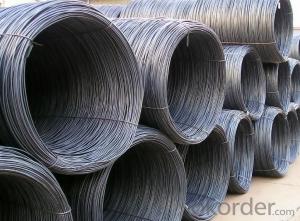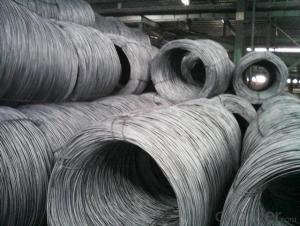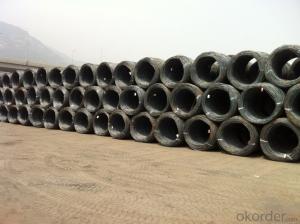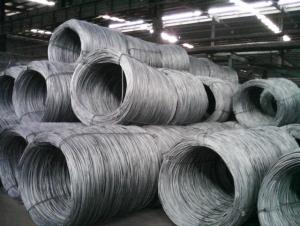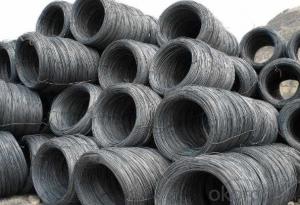Sae1006B+ Sae1008B High quality Wire Rod
- Loading Port:
- Tianjin
- Payment Terms:
- TT OR LC
- Min Order Qty:
- 100 m.t
- Supply Capability:
- 20000 m.t/month
OKorder Service Pledge
OKorder Financial Service
You Might Also Like
Product Description:
OKorder is offering Sae1006B+ Sae1008B High quality Wire Rod at great prices with worldwide shipping. Our supplier is a world-class manufacturer of steel, with our products utilized the world over. OKorder annually supplies products to European, North American and Asian markets. We provide quotations within 24 hours of receiving an inquiry and guarantee competitive prices.
Product Applications:
Sae1006B AND Sae1008B High quality Wire Rod are ideal for structural applications and are widely used in the construction of buildings and bridges, and the manufacturing, petrochemical, and transportation industries.
Product Advantages:
OKorder's Sae1006B+ Sae1008B Wire Rod are durable, strong, and resist corrosion.
Main Product Features:
· Premium quality
· Prompt delivery & seaworthy packing (30 days after receiving deposit)
· Corrosion resistance
· Can be recycled and reused
· Mill test certification
· Professional Service
· Competitive pricing
Product Description:
Specifications of Sae1006B AND Sae1008B High quality Wire Rod :
Steel Grade: sae1006+sae1008B , Standard: GB Diameter: 5.5mm, 6.5mm, 7mm,8mm,9mm,10mm,12mm,14mm
Diameter Tolerance:±0.3mm 6.5mm can be drawing into 2mm/8.0mm can be drawing into 3mm
Brand Name: N-RIVER Place of Origin: Hebei, China Mainland Application: construction, building etc
Chemical Composition:
Please kindly find our chemistry of our material based on Q235 as below for your information
Trademark | Rank | Chemical composition (quality score) % | ||||||
C | Si | Mn | S | P | ||||
| ≤ |
| ≤ | ≤ | ||||
Q235 | A | 0.14-0.22 | 0.30 | 0.30-0.65 | 0.050 | 0.045 | ||
Q235 | B | 0.12-0.20 | 0.30 | 0.30-0.70 | 0.045 | 0.045 | ||
Trademark | Rank | Pulling Test | ||||||
Bend PointΔs/Mpa | Tensile Strength | Elongation Ratioδ5% | ||||||
Thickness (Diameter) /MM | Thickness (Diameter) /MM | |||||||
≤16 | 16-40 | ≤16 | 16-40 | |||||
≥ | ≥ | |||||||
Q235 | A | 235 | 225 | 375-500 | 26 | 25 | ||
Q235 | B | 235 | 225 | 375-500 | 26 | 25 | ||
Usage and Applications of Wire Rod Sae1006B AND Sae1008B :
After hot-rolled the products shaped into coil and delivery as finished product, including round, square, rectangular, hexagonal and so on. Since most of the products are round, it is generally called wire rod. Carbon steel wire rod is widely used in construction and manufacturing. Carbon steel wire rod is mainly used for reinforcement of reinforced concrete and welded structure or reprocessed (roberts , nail, etc.) materials, especially used to produce wire drawing, welding electrode, nails, spring, electronic, precise machinery parts and so on.
Packaging & Delivery of Wire Rod Sae1006B AND Sae1008B :
Packaging Detail: products are packed in coil and then shipped by container or bulk vessel
Each coil weight: 2-3MT
Delivery Detail: within 45 days after received deposit or LC.
Label: to be specified by customer, generally, each bundle has 1-2 labels
Trade terms: FOB, CFR, CIF
FAQ:
Q1: Why buy Materials & Equipment from OKorder.com?
A1: All products offered byOKorder.com are carefully selected from China's most reliable manufacturing enterprises. Through its ISO certifications, OKorder.com adheres to the highest standards and a commitment to supply chain safety and customer satisfaction.
Q2: Can stainless steel rust?
A2: Stainless does not "rust" as you think of regular steel rusting with a red oxide on the surface that flakes off. If you see red rust it is probably due to some iron particles that have contaminated the surface of the stainless steel and it is these iron particles that are rusting. Look at the source of the rusting and see if you can remove it from the surface.
Q3: What is the normal tolerance of Hot Rolled Mild Steel Angle Beams for Structures and for Buildings?
A3: Normally 3%-5%, but we can also produce the goods according to the customers' requests.
Images:
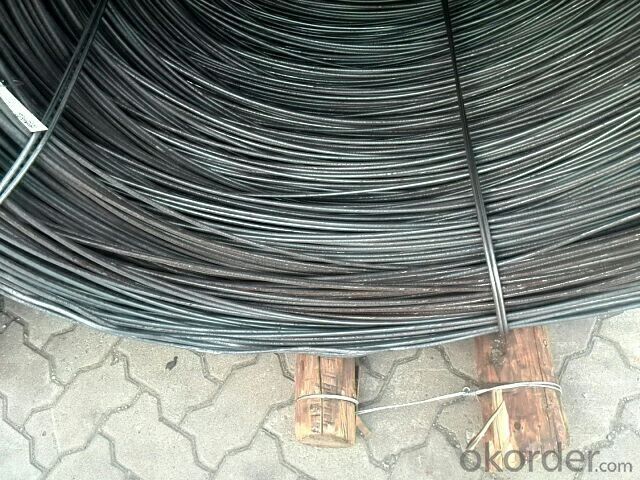
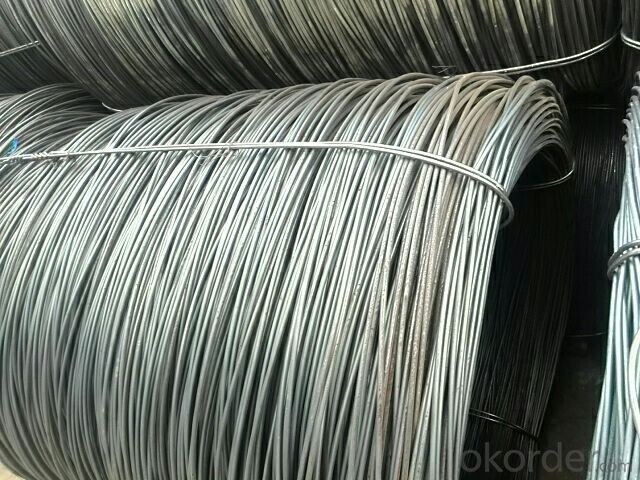
- Q: How is steel wire rod used in the manufacturing of wire forms for conveyor belts?
- To manufacture wire forms for conveyor belts, a crucial component is steel wire rod. Typically made of carbon or stainless steel, this high-quality wire rod is heated and passed through rollers to reduce its diameter to the desired size for the wire forms. Once properly sized, the wire rod is then shaped into various wire forms used in conveyor belts. Depending on the specific design requirements, these wire forms can be spiral wires, straight wires, or preformed wires. Crafted with care, these wire forms provide durability, strength, and flexibility. This is essential as conveyor belts endure continuous and heavy-duty use, carrying different materials and products. The wire forms provide the necessary support and structure for the belt to function effectively. In addition to structural support, wire forms also play a crucial role in tracking and guiding the conveyor belt. Strategically positioned, they help maintain the belt's alignment and prevent it from deviating from its intended path. This promotes smooth and reliable operation, reducing downtime and maximizing productivity. Moreover, steel wire rod chosen for wire forms in conveyor belts is known for its corrosion resistance and high tensile strength. This ensures the wire forms can withstand harsh environmental conditions, such as moisture, chemicals, and extreme temperatures, without compromising their integrity. Overall, steel wire rod is an essential component in manufacturing wire forms for conveyor belts. It provides the necessary strength, durability, and flexibility for efficient conveyor systems. By selecting high-quality steel wire rod and employing precise manufacturing techniques, conveyor belt manufacturers can produce wire forms that meet the specific needs of their customers, resulting in reliable and long-lasting conveyor belt systems.
- Q: How are steel wire rods used in the manufacturing of strings for musical instruments?
- Steel wire rods are used in the manufacturing of strings for musical instruments because of their high tensile strength and durability. These rods are first drawn into thin wires, which are then wound tightly together to form the core of the string. The core is then further wrapped with materials such as nickel, silver, or bronze to enhance the tone and playability of the string. The use of steel wire rods ensures that the strings have the necessary strength and flexibility to produce clear and resonant sound when played on musical instruments.
- Q: What are the different types of steel wire rod cooling methods?
- There are several different types of steel wire rod cooling methods, including air cooling, water cooling, and controlled cooling.
- Q: How does the diameter of steel wire rod affect its strength?
- The diameter of a steel wire rod directly affects its strength. Generally, a larger diameter wire rod will have higher strength compared to a smaller diameter wire rod. This is because a larger diameter rod has a greater cross-sectional area, allowing it to withstand higher loads and stresses without breaking or deforming.
- Q: What are the strength requirements for steel wire rod used in suspension bridge wire strands?
- The strength requirements for steel wire rod used in suspension bridge wire strands can vary depending on several factors. Generally, the wire rod must possess high tensile strength to withstand the immense loads and stresses that suspension bridges are subjected to. The wire rod must have a minimum yield strength and ultimate tensile strength that meets or exceeds the design requirements for the suspension bridge. The yield strength refers to the amount of stress that the wire rod can withstand before it begins to deform permanently, while the ultimate tensile strength indicates the maximum stress the wire rod can endure before it breaks. In addition to high strength, the wire rod must also exhibit good ductility and toughness. Ductility refers to the ability of the material to deform without fracturing, while toughness is its ability to absorb energy without fracturing. These properties are crucial for structural integrity as they allow the wire strand to flex and absorb dynamic loads, such as wind or vehicle vibrations, without failure. Furthermore, the wire rod should have excellent corrosion resistance to ensure the longevity and durability of the suspension bridge. Corrosion can weaken the wire strands over time, compromising the structural integrity of the bridge. Therefore, the wire rod must possess a protective coating or be made from corrosion-resistant alloys to withstand exposure to environmental factors such as moisture, saltwater, and pollutants. Finally, the dimensional requirements of the wire rod, including its diameter and surface finish, must also meet the specifications of the suspension bridge design. These dimensions are crucial for maintaining the desired strength and performance characteristics of the wire strands. In summary, the strength requirements for steel wire rod used in suspension bridge wire strands include high tensile strength, good ductility, toughness, corrosion resistance, and adherence to dimensional specifications. Meeting these requirements ensures the wire strands can withstand the significant loads and environmental conditions experienced by suspension bridges, ensuring their structural integrity and safety.
- Q: How are steel wire rods used in the production of barbed fences?
- Due to their strength and durability, steel wire rods play a crucial role in the manufacturing of barbed fences. These wire rods serve as the fundamental material for producing the barbed wire used for constructing these fences. The process begins by passing the steel wire rods through a series of dies, which reduces their diameter and increases their length. This wire drawing process ensures that the wire rods have a consistent thickness and strength. Once the desired thickness is achieved, the wire rods are twisted together to form a sturdy and resilient wire strand. This wire strand is then modified by adding sharp and pointed barbs at regular intervals. Typically, the barbs are created by cutting the wire strand and bending the cut ends outward, resulting in a hook-like structure. This design effectively deters trespassers and animals from crossing the fence. The resulting barbed wire is then wound onto rolls, making it easy to unroll and attach to fence posts or other support structures during installation. The sharp barbs on the wire act as a deterrent, making it challenging for intruders or livestock to pass through the fence without getting caught or injured. In conclusion, steel wire rods are essential for producing barbed fences due to their strength, durability, and flexibility. The addition of barbs to the wire strand further enhances the security provided by these fences, making them widely used in various applications, including agricultural fencing, military installations, and perimeter security.
- Q: What are the different weldability testing methods for steel wire rod?
- There are several different weldability testing methods for steel wire rod. These include the macroscopic examination, which involves visually inspecting the weld for any defects or anomalies; the bend test, where the weld is bent to evaluate its ductility and resistance to cracking; the tensile test, which measures the strength and elongation of the weld; the hardness test, which determines the hardness of the weld and its susceptibility to cracking; and the impact test, which assesses the weld's ability to withstand sudden loads and impacts.
- Q: How is steel wire rod used in the production of wire for mesh filters?
- Steel wire rod is an essential component in the production of wire for mesh filters. The wire rod is first processed through a series of steps to ensure its quality and performance. It is often hot rolled to achieve the desired shape, size, and strength. This process involves heating the steel wire rod to high temperatures and passing it through a series of rollers to shape it into a uniform and continuous wire. Once the wire rod is hot rolled, it is then cooled and further processed to remove any scale or imperfections on its surface. This ensures that the wire is smooth and free from any defects that could compromise the quality of the final mesh filter. The wire rod is then drawn through a series of dies to reduce its diameter and increase its length. This process, known as wire drawing, also helps improve the wire's strength and tensile properties. The drawn wire is then either woven or welded to form the mesh filter. In the weaving process, the wire is interlaced in a crisscross pattern to create a mesh structure. This method is commonly used for finer mesh filters that require high precision and accuracy. On the other hand, the welding process involves joining individual wires together using heat or pressure to create a solid mesh structure. This method is typically used for larger mesh filters or those that require higher strength and durability. The steel wire rod used in the production of wire for mesh filters is crucial as it determines the quality and performance of the final product. The composition and tensile strength of the wire rod are carefully selected to meet the specific requirements of the mesh filter. It is important to use a high-quality wire rod that offers excellent corrosion resistance, durability, and dimensional stability to ensure the longevity and effectiveness of the mesh filter. In summary, steel wire rod plays a vital role in the production of wire for mesh filters. It undergoes various processes such as hot rolling, wire drawing, and surface treatment to achieve the desired properties. The wire rod is then woven or welded to form the mesh structure, which determines the filter's precision, strength, and durability. By using high-quality steel wire rod, manufacturers can produce superior mesh filters that effectively meet the filtration needs of various industries.
- Q: What are the main challenges in steel wire rod production?
- There are several main challenges in steel wire rod production that manufacturers typically face. One of the primary challenges is ensuring consistent quality and uniformity in the wire rod products. Since steel wire rods are used in various applications such as construction, automotive, and manufacturing industries, it is crucial to maintain strict quality control measures to meet the specific requirements and standards of each sector. Another significant challenge is optimizing the production process to achieve high productivity and efficiency. Steel wire rod production involves multiple stages, including melting, casting, rolling, and finishing. Each stage requires proper equipment, skilled operators, and precise control to minimize downtime, reduce waste, and maximize output. Manufacturers must continuously analyze and refine their production processes to achieve optimal efficiency. Furthermore, the global steel industry faces environmental challenges, including reducing energy consumption, minimizing carbon emissions, and implementing sustainable practices. Steel wire rod production consumes significant energy, especially during the melting and rolling processes. Manufacturers are constantly exploring innovative technologies and methods to improve energy efficiency, recycle waste materials, and reduce the environmental impact of their operations. Supply chain management is another critical challenge in steel wire rod production. Manufacturers need to ensure a steady supply of raw materials, such as iron ore and scrap metal, and maintain strong relationships with suppliers. Additionally, they must manage logistics efficiently to deliver finished products to customers promptly and reliably. Lastly, the steel wire rod market is highly competitive, with numerous domestic and international players. Manufacturers must continuously innovate and adapt to market trends, customer demands, and changing regulations to remain competitive. They need to invest in research and development, product diversification, and marketing strategies to differentiate themselves and maintain a strong market position. In summary, the main challenges in steel wire rod production revolve around quality control, production efficiency, environmental sustainability, supply chain management, and market competitiveness. Overcoming these challenges requires continuous improvement, technological advancements, and strategic decision-making to ensure success in this demanding industry.
- Q: How does the price of steel wire rod fluctuate in the market?
- The price of steel wire rod fluctuates in the market due to a variety of factors. One significant factor is the supply and demand dynamics within the steel industry. When there is a high demand for steel wire rod, such as during periods of economic growth or construction booms, the price tends to increase. Conversely, when there is a decrease in demand or oversupply of steel wire rod, the price tends to decrease. Another factor that affects the price of steel wire rod is the cost of raw materials. Steel wire rod is typically made from iron ore, which is subject to price fluctuations in the global market. If the cost of iron ore increases, it can lead to higher production costs for steel manufacturers, resulting in higher prices for steel wire rod. Additionally, fluctuations in energy prices can impact the price of steel wire rod. Steel production requires a significant amount of energy, particularly in the form of electricity and natural gas. If energy prices rise, it can increase the cost of production, leading to higher prices for steel wire rod. Furthermore, changes in trade policies and tariffs can also influence the price of steel wire rod. Governments may impose tariffs or trade restrictions on steel imports, which can restrict the supply of steel wire rod in the market and potentially raise prices. Lastly, market speculation and investor sentiment can also contribute to price fluctuations in the steel wire rod market. Investors and traders may anticipate future changes in supply and demand or react to economic indicators, resulting in volatile price movements. Overall, the price of steel wire rod is subject to a range of factors including supply and demand dynamics, raw material costs, energy prices, trade policies, and market speculation. These factors can cause the price to fluctuate in response to changes in the broader economy and industry conditions.
Send your message to us
Sae1006B+ Sae1008B High quality Wire Rod
- Loading Port:
- Tianjin
- Payment Terms:
- TT OR LC
- Min Order Qty:
- 100 m.t
- Supply Capability:
- 20000 m.t/month
OKorder Service Pledge
OKorder Financial Service
Similar products
Hot products
Hot Searches
Related keywords
